The Coupling and Coordination of Agricultural Carbon Emissions Efficiency and Economic Growth in the Yellow River Basin, China
Abstract
1. Introduction
2. Materials and Methods
2.1. Research Area
2.2. Index System Construction and Data Source
2.3. Super-Efficient SBM Model Based on Undesired Outputs
2.4. The Coupling Coordination Degree Model
2.5. The Dagum Gini Coefficient
2.6. The Kernel Density Estimation Method
3. Results and Analysis
3.1. Analysis of the Status Quo Characteristics of Agricultural Carbon Emissions Efficiency
3.2. Analysis of the Coupling and Coordination between Agricultural Carbon Emission Efficiency and Economic Growth
3.3. Analysis of Regional Differences and Sources of Coupled Coordination between Agricultural Carbon Emission Efficiency and Economic Growth
3.3.1. Overall Regional Differences in the Degree of Coordination of Coupled Agricultural Carbon Emission Efficiency and Economic Growth in the YRB
3.3.2. Inter-Regional Variation in the Degree of Coordination between the Coupling of Agricultural Carbon Emissions Efficiency and Economic Growth in the YRB
3.3.3. The Contribution of Sources to the Spatial Variation in the Degree of Coupled Coordination between Agricultural Carbon Emissions Efficiency and Economic Growth in the YRB
3.4. Dynamic Evolution of the Degree of Coupled Coordination between Agricultural Carbon Emissions Efficiency and Economic Growth
3.4.1. Kernel Density Estimate Based on the Overall Level of the YRB
3.4.2. Kernel Density Estimate Based on the Local Level of the YRB
4. Discussion and Conclusions
4.1. Results and Discussion
4.2. Conclusions and Policy Suggestions
- (1)
- In terms of typical facts, there is still considerable room for improvement in the efficiency of agricultural carbon emissions in the YRB. In the upper, middle, and lower reaches of the YRB, a significant stepwise imbalance was observed. In addition, there were also significant differences in the degree of coupling and coordination between agricultural carbon emissions efficiency and economic growth in the YRB. At the same time, the degree of coupling and coordination exhibited a spatial distribution pattern of “high in the west and low in the east,” and the degree of coupling and coordination in most cities demonstrated varying degrees of decline over the sample observation period.
- (2)
- In terms of regional differences, there was a significant spatial non-equilibrium in the coupling and coordination degree of agricultural carbon emissions efficiency and economic growth in the YRB. When comparing the three major regions, the differences in the coupling and coordination of agricultural carbon emissions efficiency and economic growth in the YRB were noticed significantly, with the spatial non-equilibrium decreasing in the downstream, midstream, and upstream regions on a sequential basis.
- (3)
- In terms of dynamic evolution, the main peak of the kernel density estimation curve for the YRB exhibited a leftward shift, further indicating the decreasing trend of coupling coordination during the sample observation period.
- (1)
- To enhance the coupling and coordination of agricultural carbon emissions efficiency and economic growth in the YRB, it is essential to take into account both the overall perspective of the YRB and the differences in geographical location, resource endowment, and ecological and environmental conditions of the three major regions in the YRB. At the same time, it is necessary to follow the principles of local adaptation and coordinated development in order to improve the overall layout of ecological protection along with high-quality economic development in the YRB, based on the perspective of coordinated regional development.
- (2)
- We should fully understand the importance and urgency of the coupled and coordinated development of agricultural carbon emissions efficiency and economic growth in the YRB. Similarly, we should recognize that there is still considerable room for improvement in the efficiency of agricultural carbon emissions, as well as the degree of coupling and coordination in the YRB. At the same time, we should be aware that inter-regional differences are the predominant source of spatial differences in the degree of coupling and coordination in the YRB and that the spatial differences are most severe between the upstream and downstream. According to this characteristic, we should establish a solid idea by taking into account the overall interest of the whole country; establish a comprehensive mechanism for coordinated development in the upper, middle, and lower streams of the YRB; and develop a cooperation mechanism whereby the wise seek common interest. At the same time, it is also immensely crucial to accelerate the coordinated development of the whole basin in essential areas, such as ecology and environment, infrastructure, and technological research, in order to form a pattern of coordinated development in the three regions.
4.3. Limitations and Future Prospects
Author Contributions
Funding
Institutional Review Board Statement
Informed Consent Statement
Data Availability Statement
Conflicts of Interest
References
- Davis, S.J.; Caldeira, K.; Matthews, H.D. Future CO2 emissions and climate change from existing energy infrastructure. Science 2010, 5997, 1330–1333. [Google Scholar] [CrossRef] [PubMed]
- Ren, B.P.; Zhang, Q. Strategic Design and Supporting System Construction of High-quality Development in the Yellow River Basin. Reform 2019, 308, 26–34. [Google Scholar]
- Jin, F.J. Coordinated promotion strategy of ecological protection and high-quality development in the Yellow River Basin. Reform 2019, 11, 33–39. [Google Scholar]
- Liu, T.; Xu, Z.Y. The Co-evolution of Economic Development, Green Innovation and Ecological Environment in the Yellow River Basin. Stat. Decis. 2022, 38, 105–109. [Google Scholar] [CrossRef]
- Zhou, Q.X.; He, A.P. Can Environmental Regulation Promote High-quality Development of the Yellow River Basin. Financ. Econ. 2020, 6, 89–104. [Google Scholar]
- Xi, J.P. Speech at the symposium on ecological protection and high-quality development in the Yellow River basin. Seek. Truth 2019, 20, 1–5. [Google Scholar]
- Xi, J.P. Jointly do a good job of great protection and coordinated promotion of great governance to make the Yellow River a river of happiness that benefits the people. People’s Dly. 2019, (Version 1, September 20). Available online: http://www.hwswj.com.cn/news/show-171112.html (accessed on 28 November 2022).
- Haan, C. Livestock’s Long Shadow: Environmental Issues and Options; Food and Agriculture Organization of the United Nations (FAO): Rome, Italy, 2006; Available online: https://www.fao.org/3/a0701e/a0701e00.htm (accessed on 18 August 2022).
- Chen, X.; Meng, Q.; Shi, J.; Liu, Y.; Sun, J.; Shen, W. Regional Differences and Convergence of Carbon Emissions Intensity in Cities along the Yellow River Basin in China. Land 2022, 11, 1042. [Google Scholar] [CrossRef]
- Chen, M.H.; Yue, H.J.; Hao, Y.F.; Liu, W.F. The Spatial Disparity, Dynamic Evolution and Driving Factors of Ecological Effificiency in the Yellow River Basin. J. Quant. Tech. Econ. 2021, 38, 25–44. [Google Scholar]
- West, T.O.; Marland, G. A synthesis of carbon sequestration, carbon emissions, and net carbon flux in agriculture: Comparing tillage practices in the United States. Agric. Ecosyst. Environ. 2002, 91, 217–232. [Google Scholar] [CrossRef]
- Dong, H.M.; Li, Y.E.; Tao, X.P.; Peng, X.P.; Li, N.; Zhu, Z.P. Technical Countermeasures for Greenhouse Gas Emissions from Agricultural Sources and Reduction in China. China J. Agric. Eng. 2008, 24, 269–273. [Google Scholar]
- Lal, R. Carbon emission from farm operations. Environ. Int. 2004, 30, 981–990. [Google Scholar] [CrossRef]
- Li, G.Z.; Li, Z.Z. An Empirical Analysis of Factors Decomposing Carbon Emissions in China’s Agricultural Energy Consumption—Based on the LMDI Model. J. Agric. Econ. 2010, 10, 66–72. [Google Scholar] [CrossRef]
- Tian, Y.; Zhang, J.B.; Li, B. Research on China’s agricultural carbon emissions: Measurement, spatio-temporal comparison and decoupling effect. Res. Sci. 2012, 34, 2097–2105. [Google Scholar]
- Min, J.S.; Hu, H. Calculation of Greenhouse Gas Emissions from Agricultural Production in China. China Popul. Res. Environ. 2012, 22, 21–27. [Google Scholar]
- Tian, Y.; Yin, H.H. Re-estimation of China’s agricultural carbon emissions: Basic status quo, dynamic evolution and spatial spillover effects. China Rural Econ. 2022, 3, 104–127. [Google Scholar]
- Liu, D.J.; Zhou, Q. Calculation and convergence test of agricultural total factor productivity under carbon emission constraints. J. Fujian Agric. 2017, 32, 99–106. [Google Scholar] [CrossRef]
- Zhao, X.C.; Song, L.M. Research on the relationship between carbon emissions from agricultural land use and agricultural economy in Hunan Province. J. Ecol. Rural Environ. 2018, 34, 976–981. [Google Scholar]
- Yao, C.S.; Qian, S.S.; Li, Z.T.; Bai, C.Q. Research on the relationship between agricultural carbon emissions, technological investment and economic growth in Heilongjiang Province. Chin. J. Agric. Res. Reg. Plan. 2017, 38, 8–15. [Google Scholar]
- Li, K.Q.; Ma, D.D. Research on the relationship between economic development, technological progress and agricultural carbon emission growth in Jiangsu Province. Sci. Tech. Mgt. Res. 2018, 38, 77–83. [Google Scholar]
- Tian, W.; Yang, L.J.; Jiang, J. Measurement and Analysis of China’s Agricultural Environmental Efficiency from a Low-Carbon Perspective: An SBM Model Based on Undesirable Output. China Rural Obs. 2014, 5, 59–71. [Google Scholar]
- Li, G.Z.; Li, Z.Z.; Zhou, M. An Empirical Analysis of the Relationship between Carbon Emissions and Agricultural Economic Growth. Agric. Econ. Mgt. 2011, 4, 32–39. [Google Scholar]
- Li, Z.M.; Song, K.; Sun, Y.H. An Empirical Measurement of Decoupling Indicators between Carbon Emissions and Economic Growth. Stat. Decis. 2011, 31, 86–88. [Google Scholar] [CrossRef]
- Holtz-Eakin, D.; Selden, T.M. Stoking the fires? CO2 emissions and economic growth. J. Public Econ. 1995, 57, 85–101. [Google Scholar] [CrossRef]
- Moomaw, W.R.; Unruh, G.C. Are environmental Kuznets curves misleading us? The case of CO2 emissions. Environ. Devel. Econ. 1997, 2, 451–463. [Google Scholar] [CrossRef]
- Zhang, L.; Pang, J.X.; Chen, X.P.; Lu, Z.M. Carbon emissions, energy consumption and economic growth: Evidence from the agricultural sector of China’s main grain-producing areas. Sci. Total Environ. 2019, 665, 1017–1025. [Google Scholar] [CrossRef] [PubMed]
- Tian, Y.; Lin, Z.J. Coupling and Coordination of Agricultural Carbon Emission Efficiency and Economic Growth in China’s Provinces. China Popul. Res. Environ. 2022, 32, 13–22. [Google Scholar]
- Wang, Y.N.; Gong, X.Y. Analysis of the Coupling Coordination between Agricultural Carbon Emissions and High-quality Economic Development in the Yangtze River Economic Belt. Reform Open. Up 2021, 40, 1–10. [Google Scholar] [CrossRef]
- Zheng, C.D.; Liu, S. Analysis of Carbon Emissions and Economic Growth Based on Spatial Econometrics. China. Popul. Res. Environ. 2011, 21, 80–86. [Google Scholar]
- Song, M.; Hao, X.G.; Liu, J.B. Spatio-temporal evolution characteristics of carbon balance and decoupling effect of economic growth in the Yellow River Basin. Urban Probl. 2021, 07, 91–103. [Google Scholar]
- Li, Z.G.; Wang, J. Spatiotemporal Transition Effects of Carbon Intensity in the Economic Accumulation of the Yellow River Basin. East China Econ. Mgt. 2020, 34, 61–71. [Google Scholar]
- Song, M.; Zou, S.J. Regional Differences, Convergence and Influencing Factors of Carbon Emissions Efficiency in the Yellow River Basin. Yellow River 2022, 44, 6–12. [Google Scholar]
- Guo, S.D.; Qian, Y.B.; Zhao, R. Efficiency and Convergence Analysis of Agricultural Carbon Emissions in Western China–Based on SBM-Undesirable Model. Rural Econ. 2018, 11, 80–87. [Google Scholar]
- Tone, K. A slacks-based measure of efficiency in data envelopment analysis. Eur. J. Oper. Res. 2001, 130, 498–509. [Google Scholar] [CrossRef]
- Xu, W.X.; Li, L.; Zhou, J.P.; Liu, C.J. The dynamic evolution of the coupling coordination between rural revitalization and new urbanization and its driving mechanism. China J. Nat. Res. 2020, 35, 2044–2062. [Google Scholar]
- Fan, J.; Wang, Y.F.; Wang, Y.X. Research on Regional High-Quality Development Based on Geographical Units–Also on the Differences and Key Points of the Development of the Yellow River Basin and the Yangtze River Basin. Econ. Geogr. 2020, 40, 1–11. [Google Scholar] [CrossRef]
- Liu, K.; Qiao, Y.R.; Shi, T.; Zhou, Q. Study on Coupling Coordination and Spatiotemporal Heterogeneity between Economic Development and Ecological Environment of Cities Along the Yellow River Basin. Environ. Sci. Pollut. Res. 2021, 28, 6898–6912. [Google Scholar] [CrossRef] [PubMed]
- Zhou, Y.; Li, W.; Li, H.; Wang, Z.; Zhang, B.; Zhong, K. Impact of Water and Land Resources Matching on Agricultural Sustainable Economic Growth: Empirical Analysis with Spatial Spillover Effects from Yellow River Basin, China. Sustainability 2022, 14, 2742. [Google Scholar] [CrossRef]
- Lan, F.; Hui, Z.; Bian, J.; Wang, Y.; Shen, W. Ecological Well-Being Performance Evaluation and Spatio-Temporal Evolution Characteristics of Urban Agglomerations in the Yellow River Basin. Land 2022, 11, 2044. [Google Scholar] [CrossRef]
- Zhao, Y.; Hou, P.; Jiang, J.; Zhai, J.; Chen, Y.; Wang, Y.; Bai, J.; Zhang, B.; Xu, H. Coordination Study on Ecological and Economic Coupling of the Yellow River Basin. Int. J. Environ. Res. Public Health 2021, 18, 10664. [Google Scholar] [CrossRef]
- Li, S.; Cheng, Z.; Tong, Y.; He, B. The Interaction Mechanism of Tourism Carbon Emission Efficiency and Tourism Economy High-Quality Development in the Yellow River Basin. Energies 2022, 15, 6975. [Google Scholar] [CrossRef]
- An, S.; Zhang, S.; Hou, H.; Zhang, Y.; Xu, H.; Liang, J. Coupling Coordination Analysis of the Ecology and Economy in the Yellow River Basin under the Background of High-Quality Development. Land 2022, 11, 1235. [Google Scholar] [CrossRef]
- Zhang, Z.; Li, H.; Cao, Y. Research on the Coordinated Development of Economic Development and Ecological Environment of Nine Provinces (Regions) in the Yellow River Basin. Sustainability 2022, 14, 13102. [Google Scholar] [CrossRef]
- Zhang, Y.; Wang, Z.; Hu, S.; Song, Z.; Cui, X.; Afriyie, D. Spatial and Temporal Evolution and Prediction of the Coordination Level of “Production-Living-Ecological” Function Coupling in the Yellow River Basin. Int. J. Environ. Res. Public Health 2022, 19, 14530. [Google Scholar] [CrossRef] [PubMed]
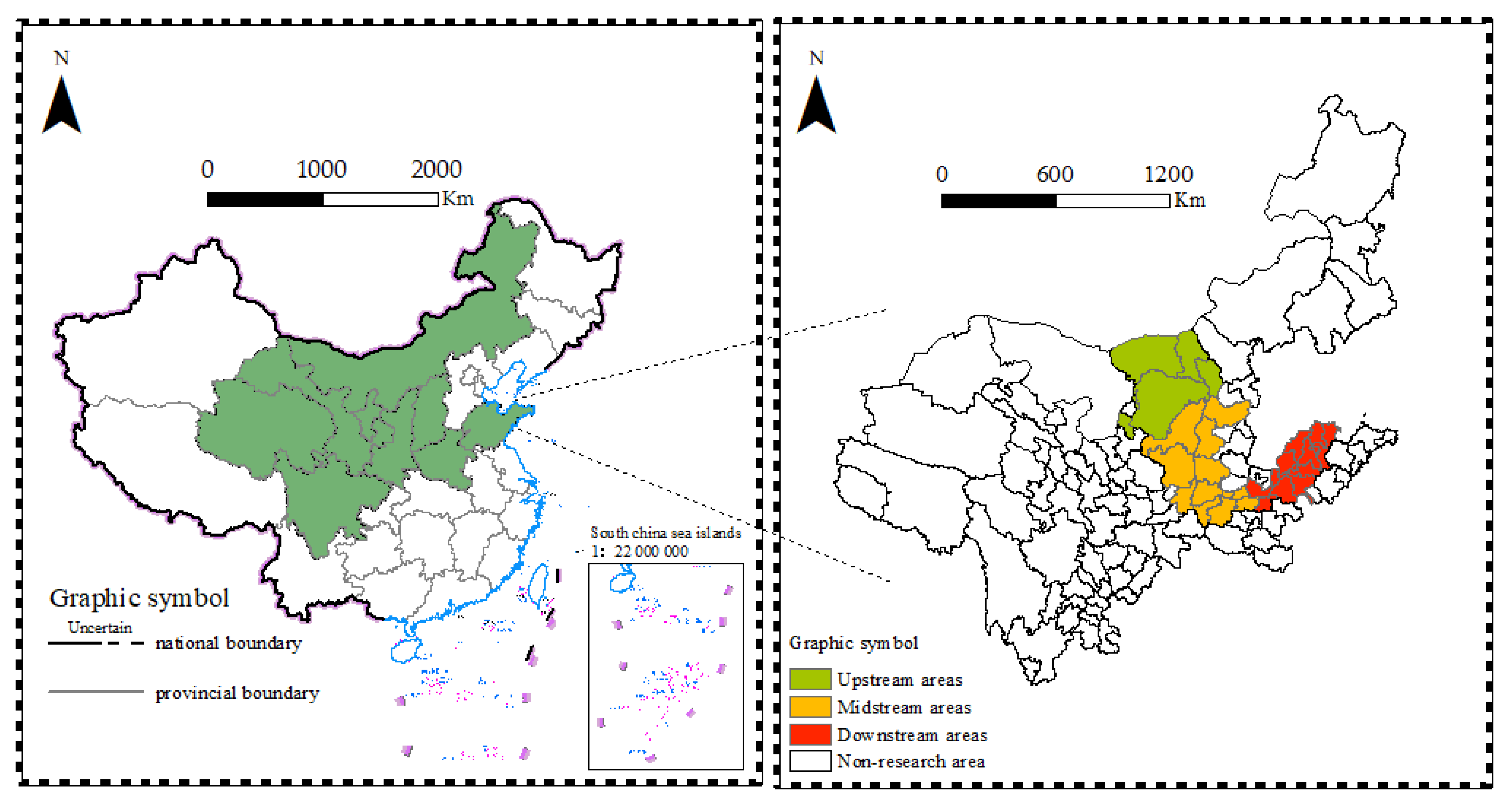
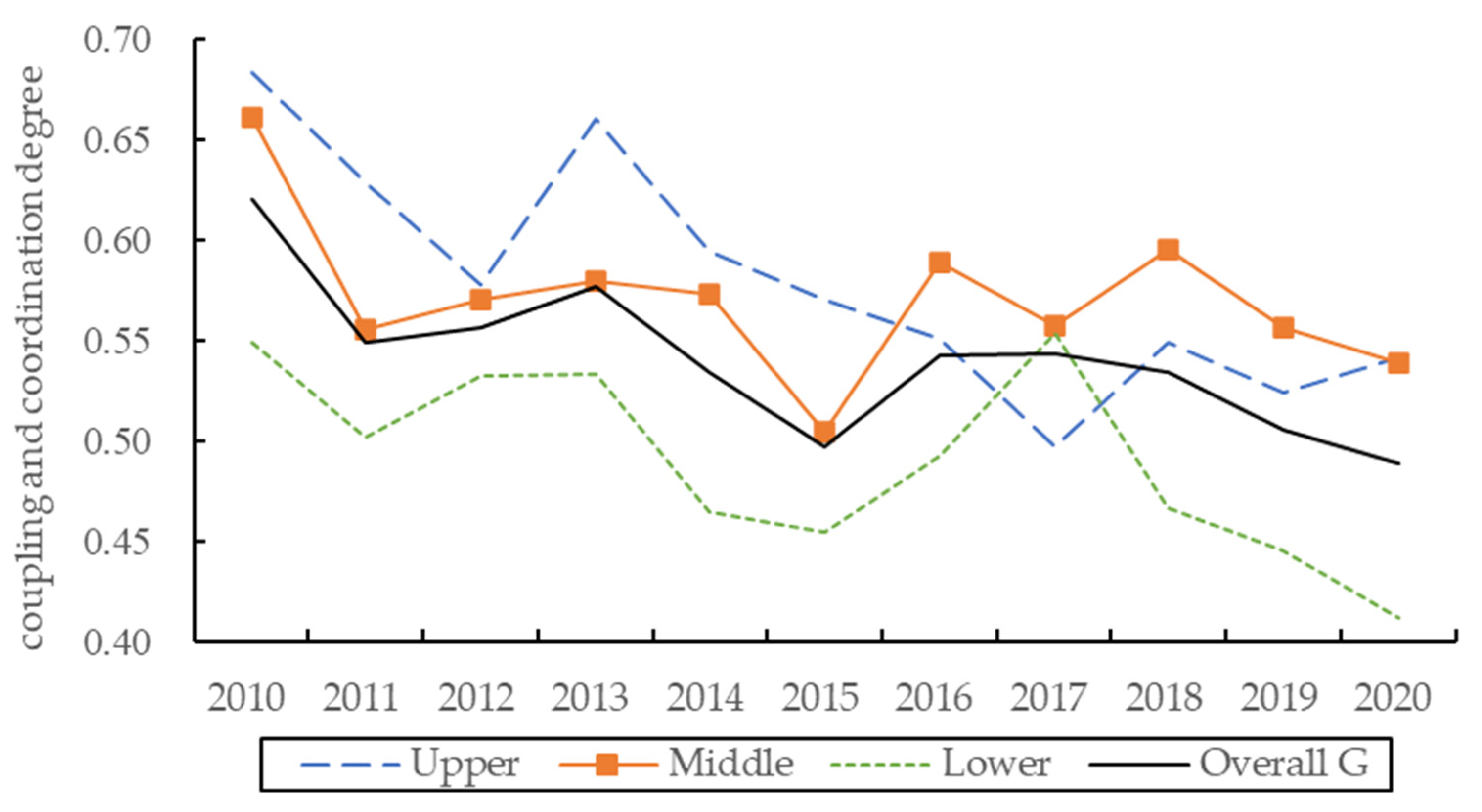
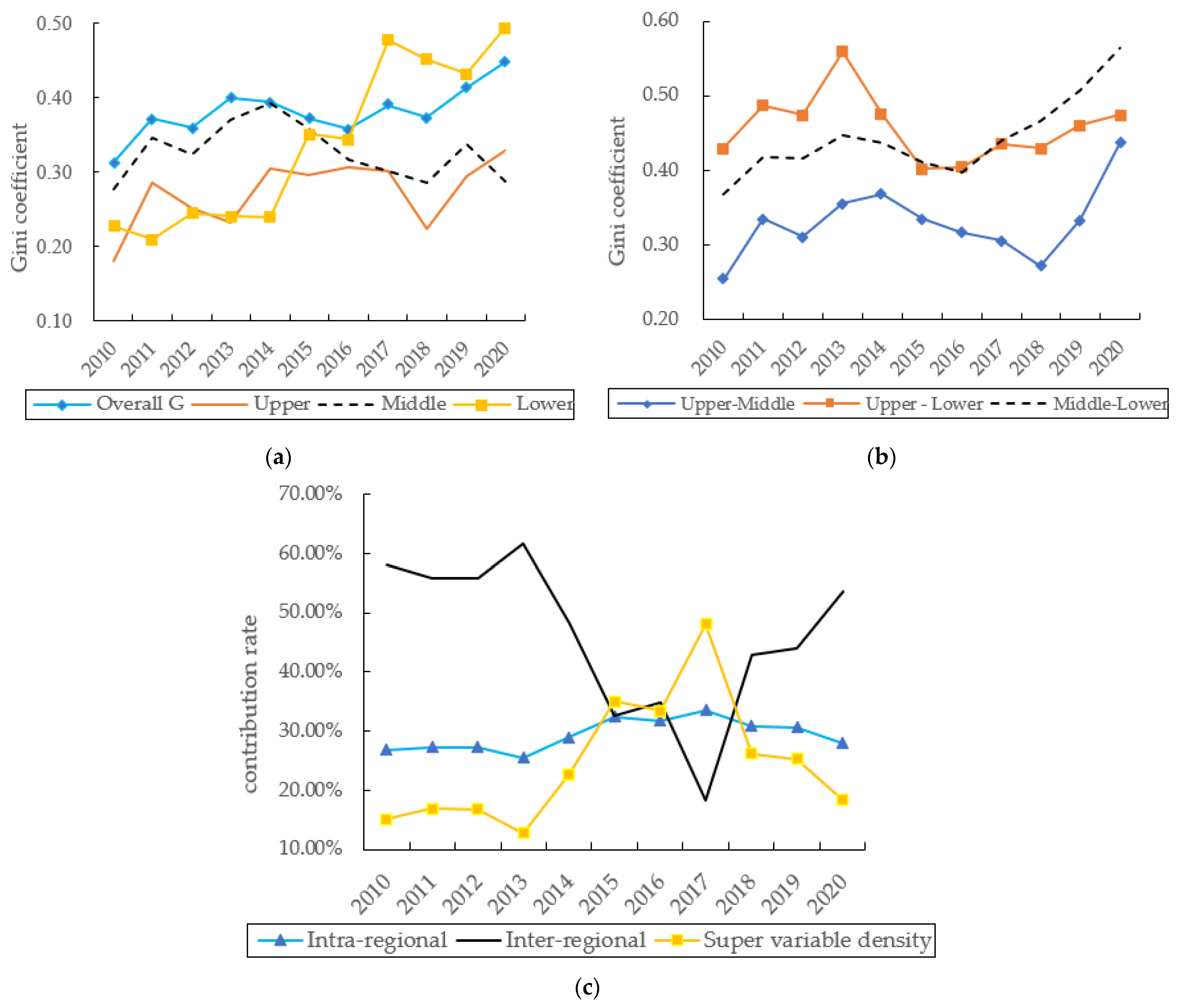


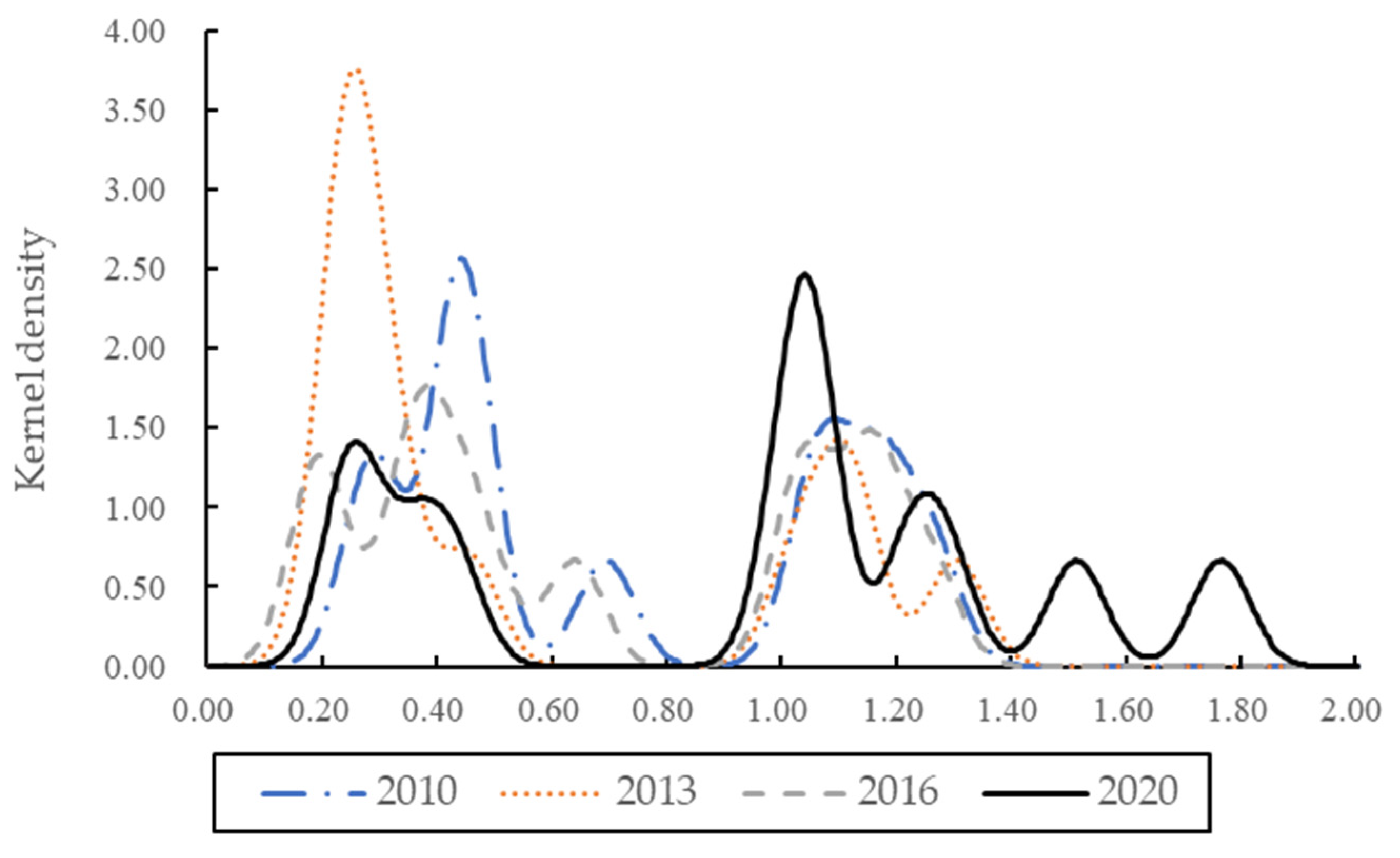
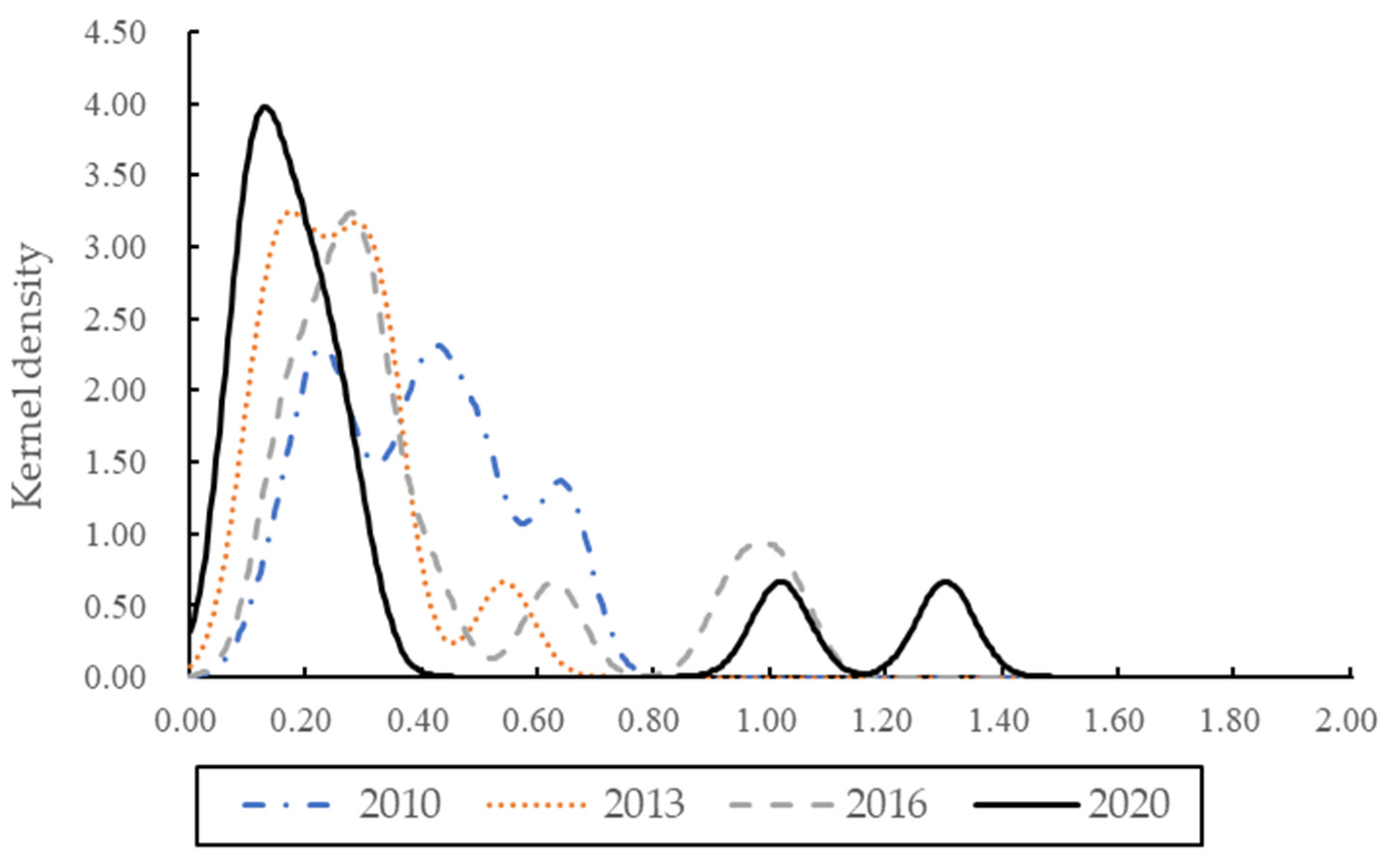
| Regions | Number | Cities |
|---|---|---|
| Upstream | 1–6 | Yinchuan, Bayannur, Baotou, Erdos, Hohhot, and Wuhai |
| Midstream | 7–18 | Jiaozuo, Linfen, Luoyang, Sanmenxia, Jiyuan, Weinan, Yuncheng, Xinzhou, Yan’an, Yulin, Zhengzhou, and Luliang |
| Downstream | 19–30 | Puyang, Xinxiang, Kaifeng, Liaocheng, Binzhou, Dezhou, Dongying, Heze, Jinan, Jining, Tai’an, and Zibo |
| Category | Dimensions | Specific Indicators | Units |
|---|---|---|---|
| Input Variables | Labour input | Primary sector workers | Ten thousand people |
| Land input | Crop sown area | Hectares | |
| Agriculture capital input | Fertilizer application rate | Million tons | |
| Pesticide used | Million tons | ||
| Agriculture film usage | Tons | ||
| Total power of agricultural machinery | Million kW | ||
| Water input | Effective irrigated area | Hectares | |
| Output variables | Expected outputs | Gross output value of agriculture, forestry, animal husbandry, and fishery | Billions of CNY |
| Non-desired outputs | Agricultural carbon emissions | Million tons |
| Type | Numerical Value | Level of Coordination |
|---|---|---|
| Coordinated Development | 0.7 ≤ D < 1 | Advanced Coordination |
| Transformational development | 0.6 ≤ D < 0.7 | Intermediate Coordination |
| 0.5 ≤ D < 0.6 | Primary Coordination | |
| Dysfunctional decline | 0.3 ≤ D < 0.5 | Near Disorder |
| 0 ≤ D < 0.3 | Mild Disorder |
| Regions | Cities | 2010 | 2013 | 2016 | 2020 |
|---|---|---|---|---|---|
| Upstream | Yinchuan | 0.466 | 1.049 | 0.246 | 0.248 |
| Bayannur | 0.494 | 0.317 | 0.314 | 0.319 | |
| Baotou | 1.108 | 1.005 | 1.017 | 0.366 | |
| Erdos | 1.122 | 0.429 | 0.465 | 0.258 | |
| Hohhot | 1.266 | 1.081 | 1.047 | 0.365 | |
| Wuhai | 1.193 | 1.379 | 1.312 | 1.308 | |
| Mean | 0.941 | 0.877 | 0.733 | 0.477 | |
| Midstream | Jiaozuo | 1.191 | 0.455 | 1.024 | 1.043 |
| Linfen | 0.442 | 0.253 | 0.197 | 0.245 | |
| Luoyang | 1.048 | 1.129 | 0.638 | 1.052 | |
| Sanmenxia | 1.076 | 1.023 | 1.049 | 1.050 | |
| Jiyuan | 0.466 | 0.225 | 1.164 | 1.512 | |
| Weinan | 0.294 | 0.258 | 0.370 | 0.354 | |
| Yuncheng | 0.430 | 0.284 | 0.340 | 1.003 | |
| Xinzhou | 0.430 | 0.262 | 0.186 | 0.254 | |
| Yan’an | 1.263 | 1.303 | 1.254 | 1.220 | |
| Yulin | 1.145 | 1.096 | 1.142 | 1.283 | |
| Zhengzhou | 0.692 | 0.342 | 0.414 | 1.764 | |
| Luliang | 0.277 | 0.219 | 0.477 | 0.426 | |
| Mean | 0.729 | 0.571 | 0.688 | 0.934 | |
| Downstream | Heze | 0.216 | 0.14 | 0.197 | 0.107 |
| Kaifeng | 0.512 | 0.541 | 0.942 | 1.301 | |
| Jinan | 0.496 | 0.315 | 0.411 | 0.258 | |
| Xinxiang | 0.642 | 0.332 | 0.626 | 1.017 | |
| Binzhou | 0.32 | 0.19 | 0.269 | 0.116 | |
| Puyang | 0.638 | 0.332 | 0.327 | 0.27 | |
| Zibo | 0.391 | 0.234 | 0.294 | 0.197 | |
| Jining | 0.418 | 0.29 | 1.025 | 0.194 | |
| Liaocheng | 0.153 | 0.115 | 0.152 | 0.113 | |
| Tai’an | 0.423 | 0.249 | 0.292 | 0.186 | |
| Dezhou | 0.235 | 0.177 | 0.257 | 0.102 | |
| Dongying | 0.237 | 0.135 | 0.17 | 0.105 | |
| Mean | 0.39 | 0.254 | 0.413 | 0.331 |
| Cities | 2010 | 2013 | 2016 | 2020 | ||||
|---|---|---|---|---|---|---|---|---|
| Yuncheng | 0.566 | Primary coordination | 0.386 | Near disorder | 0.366 | Near disorder | 0.397 | Near disorder |
| Xinzhou | 0.553 | Primary coordination | 0.342 | Near disorder | 0.460 | Near disorder | 0.409 | Near disorder |
| Linfen | 0.545 | Primary coordination | 0.610 | Intermediate coordination | 0.427 | Near disorder | 0.411 | Near disorder |
| Lvliang | 0.540 | Primary coordination | 0.335 | Near disorder | 0.617 | Intermediate coordination | 0.571 | Primary coordination |
| Huhehaote | 0.804 | Advanced coordination | 0.841 | Advanced coordination | 0.567 | Primary coordination | 0.565 | Primary coordination |
| Baotou | 0.692 | Intermediate coordination | 0.849 | Advanced coordination | 0.568 | Primary coordination | 0.527 | Primary coordination |
| Wuhai | 0.890 | Advanced coordination | 0.529 | Primary coordination | 0.726 | Advanced coordination | 0.645 | Intermediate coordination |
| Erdos | 0.560 | Primary coordination | 0.639 | Intermediate coordination | 0.521 | Primary coordination | 0.517 | Primary coordination |
| Bayannur | 0.548 | Primary coordination | 0.618 | Intermediate coordination | 0.407 | Near disorder | 0.509 | Primary coordination |
| Jinan | 0.662 | Intermediate coordination | 0.673 | Intermediate coordination | 0.462 | Near disorder | 0.374 | Near disorder |
| Zibo | 0.574 | Primary coordination | 0.353 | Near disorder | 0.529 | Primary coordination | 0.418 | Near disorder |
| Dongying | 0.476 | Near disorder | 0.478 | Near disorder | 0.371 | Near disorder | 0.401 | Near disorder |
| Jining | 0.649 | Intermediate coordination | 0.487 | Near disorder | 0.600 | Intermediate coordination | 0.346 | Near disorder |
| Tai’an | 0.658 | Intermediate coordination | 0.616 | Intermediate coordination | 0.466 | Near disorder | 0.363 | Near disorder |
| Dezhou | 0.481 | Near disorder | 0.509 | Primary coordination | 0.392 | Near disorder | 0.397 | Near disorder |
| Liaocheng | 0.392 | Near disorder | 0.493 | Near disorder | 0.402 | Near disorder | 0.294 | Mild disorder |
| Binzhou | 0.508 | Primary coordination | 0.512 | Primary coordination | 0.412 | Near disorder | 0.412 | Near disorder |
| Heze | 0.369 | Near disorder | 0.470 | Near disorder | 0.504 | Primary coordination | 0.402 | Near disorder |
| Zhengzhou | 0.655 | Intermediate coordination | 0.393 | Near disorder | 0.573 | Primary coordination | 0.718 | Advanced coordination |
| Kaifeng | 0.523 | Primary coordination | 0.782 | Advanced coordination | 0.630 | Intermediate coordination | 0.578 | Primary coordination |
| Luoyang | 0.855 | Advanced coordination | 0.882 | Advanced coordination | 0.580 | Primary coordination | 0.601 | Intermediate coordination |
| Xinxiang | 0.536 | Primary coordination | 0.383 | Near disorder | 0.629 | Intermediate coordination | 0.594 | Primary coordination |
| Jiaozuo | 0.626 | Intermediate coordination | 0.742 | Advanced coordination | 0.633 | Intermediate coordination | 0.539 | Primary coordination |
| Puyang | 0.763 | Advanced coordination | 0.648 | Intermediate coordination | 0.519 | Primary coordination | 0.375 | Near disorder |
| Sanmenxia | 0.834 | Advanced coordination | 0.867 | Advanced Coordination | 0.782 | Advanced coordination | 0.533 | Primary coordination |
| Weinan | 0.615 | Intermediate coordination | 0.713 | Advanced Coordination | 0.520 | Primary coordination | 0.448 | Near disorder |
| Yan’an | 0.735 | Advanced coordination | 0.554 | Primary coordination | 0.748 | Advanced coordination | 0.631 | Intermediate coordination |
| Yulin | 0.723 | Advanced coordination | 0.529 | Primary coordination | 0.734 | Advanced coordination | 0.649 | Intermediate coordination |
| Yinchuan | 0.605 | Intermediate coordination | 0.485 | Near disorder | 0.518 | Primary coordination | 0.489 | Near disorder |
| Jiyuan | 0.685 | Intermediate coordination | 0.603 | Intermediate coordination | 0.630 | Intermediate coordination | 0.566 | Primary coordination |
| Year | Overall G | Intra-Regional | Inter-Regional | Contribution Rate | ||||||
|---|---|---|---|---|---|---|---|---|---|---|
| Upper | Middle | Lower | Upper–Middle | Upper–Lower | Middle–Lower | Intra-Regional | Inter-Regional | Super Variable Density | ||
| 2010 | 0.3128 | 0.1803 | 0.2780 | 0.2270 | 0.2540 | 0.4295 | 0.3676 | 26.84% | 57.99% | 15.17% |
| 2011 | 0.3715 | 0.2865 | 0.3457 | 0.2098 | 0.3362 | 0.4864 | 0.4177 | 27.32% | 55.77% | 16.91% |
| 2012 | 0.3604 | 0.2512 | 0.3236 | 0.2453 | 0.3109 | 0.4749 | 0.4164 | 27.33% | 55.91% | 16.76% |
| 2013 | 0.4007 | 0.2317 | 0.3704 | 0.2408 | 0.3555 | 0.5595 | 0.4466 | 25.55% | 61.71% | 12.73% |
| 2014 | 0.3939 | 0.3049 | 0.3937 | 0.2397 | 0.3678 | 0.4756 | 0.4362 | 28.97% | 48.33% | 22.70% |
| 2015 | 0.3726 | 0.2961 | 0.3579 | 0.3514 | 0.3351 | 0.4029 | 0.4110 | 32.45% | 32.51% | 35.05% |
| 2016 | 0.3578 | 0.3061 | 0.3174 | 0.3443 | 0.3175 | 0.4049 | 0.3982 | 31.74% | 34.82% | 33.44% |
| 2017 | 0.3902 | 0.3010 | 0.3017 | 0.4779 | 0.3070 | 0.4360 | 0.4413 | 33.51% | 18.39% | 48.10% |
| 2018 | 0.3734 | 0.2243 | 0.2865 | 0.4515 | 0.2722 | 0.4296 | 0.4668 | 30.86% | 42.92% | 26.22% |
| 2019 | 0.4133 | 0.2938 | 0.3375 | 0.4326 | 0.3336 | 0.4608 | 0.5081 | 30.60% | 44.11% | 25.28% |
| 2020 | 0.4485 | 0.3297 | 0.2875 | 0.4943 | 0.4374 | 0.4749 | 0.5644 | 27.96% | 53.69% | 18.35% |
| Average | 0.3814 | 0.2732 | 0.3273 | 0.3377 | 0.3297 | 0.4577 | 0.4431 | 29.37% | 46.01% | 24.61% |
Disclaimer/Publisher’s Note: The statements, opinions and data contained in all publications are solely those of the individual author(s) and contributor(s) and not of MDPI and/or the editor(s). MDPI and/or the editor(s) disclaim responsibility for any injury to people or property resulting from any ideas, methods, instructions or products referred to in the content. |
© 2023 by the authors. Licensee MDPI, Basel, Switzerland. This article is an open access article distributed under the terms and conditions of the Creative Commons Attribution (CC BY) license (https://creativecommons.org/licenses/by/4.0/).
Share and Cite
Qing, Y.; Zhao, B.; Wen, C. The Coupling and Coordination of Agricultural Carbon Emissions Efficiency and Economic Growth in the Yellow River Basin, China. Sustainability 2023, 15, 971. https://doi.org/10.3390/su15020971
Qing Y, Zhao B, Wen C. The Coupling and Coordination of Agricultural Carbon Emissions Efficiency and Economic Growth in the Yellow River Basin, China. Sustainability. 2023; 15(2):971. https://doi.org/10.3390/su15020971
Chicago/Turabian StyleQing, Yun, Bingjian Zhao, and Chuanhao Wen. 2023. "The Coupling and Coordination of Agricultural Carbon Emissions Efficiency and Economic Growth in the Yellow River Basin, China" Sustainability 15, no. 2: 971. https://doi.org/10.3390/su15020971
APA StyleQing, Y., Zhao, B., & Wen, C. (2023). The Coupling and Coordination of Agricultural Carbon Emissions Efficiency and Economic Growth in the Yellow River Basin, China. Sustainability, 15(2), 971. https://doi.org/10.3390/su15020971





